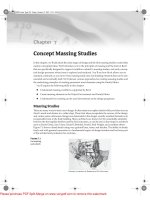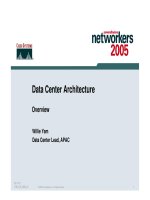Representing Landscape Architecture pptx
Bạn đang xem bản rút gọn của tài liệu. Xem và tải ngay bản đầy đủ của tài liệu tại đây (14.45 MB, 241 trang )
Representing Landscape
Architecture
It has been said that we can realize only what we can imagine; but to realize what
we imagine, we must convey those ideas to others as well as present them to
ourselves. We use images, models, and words—alone or in combination—to
conceive, study, test, construct, and evaluate new landscapes or modify old ones.
Given the transient nature of most landscapes—always growing, always changing—
landscape representation presents a special challenge. It is by no means neutral in
a political sense or even in terms of design evaluation.
Representation requires selection and thus bias, becoming as much a part of the
project as the designed landscape itself. The recent decades have witnessed a
major shift from the hand to the computer, raising new questions about the
methods and limits to what we can achieve through surrogates.
Representing Landscape Architecture
offers a broad investigation of various
mediums through which the designed landscape has been depicted. Written by a
team of renowned landscape architects and scholars, this book examines the
subject along several critical axes. First, it casts an historical eye and tests the
limits of historical images to convey their place and time. Second, it examines the
types of drawings and graphic projections used during the various stages of the
design process. Third, it presents situations that trace the relation between client
and maker and the role of representation in their transactions.
This is not a “how-to” book, but a “why” and “what” book, and it is the most
comprehensive to date on the many dimensions of landscape representation.
Marc Treib
is Professor of Architecture at the University of California, Berkeley,
and the author of numerous articles on architecture, landscape, and design. He
has held Fulbright, Guggenheim, and Japan Foundation fellowships, as well as an
advanced design fellowship at the American Academy in Rome. Recent books
include
Noguchi in Paris: The Unesco Garden
,
The Donnell and Eckbo Gardens:
Modern Californian Masterworks
and
Settings and Stray Paths: Writings on
Landscapes and Gardens
, published by Routledge in 2005.
Representing Landscape
Architecture
Edited by Marc Treib
First published 2008 by Taylor & Francis
2 Park Square, Milton Park, Abingdon, Oxon OX14 4RN
Simultaneously published in the USA and Canada
by Taylor & Francis, 270 Madison Avenue, New York, NY 10016
Taylor & Francis is an imprint of the Taylor & Francis Group,
an informa business
© Copyright 2008 Marc Treib, selection and editorial matter;
individual chapters, the contributors
All rights reserved. No part of this book may be reprinted or reproduced or
utilised in any form or by any electronic, mechanical, or other means, now
known or hereafter invented, including photocopying and recording, or in
any information storage or retrieval system, without permission in writing
from the publishers.
The authors and publishers gratefully acknowledge those who have given
permission to reproduce material in this book. Every effort has been made
to contact copyright holders for the permission to reprint material in this
book. The publishers would be grateful to hear from any copyright holder
who is not acknowledged here and will undertake to rectify any errors or
omissions in future editions of the book.
British Library Cataloging in Publication Data
A catalog record for this book is available from the British Library
Library of Congress Cataloging- in-Publication Data
A catalog record for this book has been applied for
ISBN10 0-415-70042-6 (hbk)
ISBN10 0-415-70043-4 (pbk)
ISBN13 978-0-415-70042-9 (hbk)
ISBN13 978-0-415-70043-6 (pbk)
ISBN13 978-0-203-41281-7 (ebk)
This edition published in the Taylor & Francis e-Library, 2008.
“To purchase your own copy of this or any of Taylor & Francis or Routledge’s
collection of thousands of eBooks please go to www.eBookstore.tandf.co.uk.”
ISBN 0-203-41281-8 Master e-book ISBN
For Nina Hubbs Zurier
For John Zurier
Introduction
xviii
Acknowledgments
xxi
Dianne Harris and David L. Hays
1
On the Use and Misuse
of Historical Landscape Views
22
Stephen Daniels
2
Scenic Transformation and Landscape
Improvement: Temporalities in the
Garden Designs of Humphry Repton
42
Walter Hood
3
Color Fields
56
Chip Sullivan
4
Observation and the Analytical
Representation of Space
62
Thorbjörn Andersson
5
From Paper to Park
74
Randolph Thompson Hester, Jr.
6
No Representation Without Representation
96
Marc Treib
7
On Plans
112
Contributors
236
Index
239
Dorothée Imbert
8
Skewed Realities: The Garden
and the Axonometric Drawing
124
Laurie Olin
9
Drawings at Work: Working Drawings,
Construction Documents
140
Peter Walker
10
Modeling the Landscape
160
Kirt Rieder
11
Modeling, Physical and Virtual
168
Marc Treib
12
Photographic Landscapes:
Time Stilled, Place Transposed
188
Kenneth Helphand
13
Set and Location: The Garden and Film
204
Noël van Dooren
14
From Chalk to
CAD
: Drawing Materials
in the Work of Alle Hosper
224
Plate 1 [ see also 1-1, page 22 ]
English School, Llanerch,
Denbighshire, c. 1662–1672
Yale Center for British Art,
Paul Mellon Collection, USA
Plate 2 [ see also 3-3, page 58 ]
Walter Hood. Autry National
Center, Los Angeles, California,
2006.
Plate 3 [ see also 8-7, page 131 ]
Jean Canneel-Claes, landscape
architect; Louis-Herman de
Koninck, architect. Canneel
Garden, Auderghem, Belgium,
1931. Axonometric view with
plan of house.
Archives d’Architecture Moderne
Plate 4 [ see also 5-1, page 74 ]
Fredrik Magnus Piper.
Drottningholm Castle gardens,
Sweden, 1781. Site plan.
Watercolor and ink.
Royal Swedish Art Academy,
Stockholm
designer: Olin Partnership.
Stata Center for the Computer
Sciences, Massachusetts
Institute of Technology,
Cambridge,
MA
, 2001.
Olin Partnership
Plate 6 [ see also 10-8, page 166 ]
Peter Walker and Partners,
landscape architects;
Renzo Piano, architect.
Nasher Sculpture Garden,
Dallas, Texas, 2003.
Detailed study model.
Peter Walker and Partners
Frank King. Gasoline Alley,
c. 1929.
© Tribune Media Services, Inc.
All Rights Reserved. Reprinted
with permission.
Plate 8 [ see also 11-6, page 178 ]
Hargreaves Associates.
Expo ‘98, Lisbon, Portugal, 1994.
Clay competition model.
Hargreaves Associates
Luis Barragán. San Cristobal,
Los Clubes, Mexico City,
Mexico, 1968.
Armando Salas Portugal, courtesy
of The Barragan Foundation,
Birsfelden, Switzerland / ProLitteris,
Zurich
Platea 10A, 10B [see also 13-9,
13-10, page 218]
Sally Potter, director.
Orlando, 1992,
The Sales Co., London
Bakker en Bleeker. “Stad aan
de Stroom” (City on the River),
Antwerp, Belgium, 1990.
Competition entry.
Plate 12 [ see also 14-9, page 232 ]
14-9
Alle Hosper. Beverwijk,
The Netherlands, c. 1994.
Bureau Alle Hosper
xviii
INTRODUCTION
We live in an era of the “new”: new technologies, new media, new economies,
new life styles, new political and cultural boundaries. In the design professions
we repeatedly hear the call for new building and landscape forms, and for
new ways by which to conceive and communicate them. We are told that the
old forms and old media just no longer work and that, instead, we need new
ways of visualizing and presenting design information. This may be true.
But very rarely—almost never—do we learn just what is wrong with existing
practices and just which of them might need to be revised or replaced. The
fourteen essays in this book provide a broad investigation of how landscape
architecture has been, is currently, and may be represented in the future: for
design study, for presentation, for criticism, and even for its realization.
It has been said that we can only realize what we can imagine. But in order
to realize the constructs of our imagination we must convey ideas to others
as well as to ourselves. Representation is by no means a neutral practice, and
the process of communication, the process by which the imagination takes
its first form, itself necessarily limits the range of our design possibilities.
Machines such as the computer further remove perceptual from cognitive
processes and raise new questions about methods and limits—although, of
course, they might augment the power of those processes in other ways.
Is there a link between the media and drawing types we use in creating
landscapes, both as promise and limitation? The thought behind this book
is that there is still much to be learned from where we have been, especially
when projecting where we are going: let us examine, even in a cursory
and incomplete way, the ideas and forms by which landscape architecture
is and has been graphically represented and described. As the essays will
suggest, those forms of representation have responded to a multitude of
questions, each one multi-faceted. By whom is the image made and to whom
is the communication intended? What graphic media and technologies were
available to the designers? What are the possibilities and liabilities for the
various media and for various types of graphic representations? How were
certain issues concerning landscape design addressed and conveyed in dif-
ferent historical periods? How might ideas from the past lead us to more
effective means and manners today and in the future? What is the relation
between the representation and the built form? These are the themes and
sub-themes that run through the essays, although none of them constitutes
a dominating structure. Our concerns include: descriptions of space, form,
and vegetation; representations of individual and collective goals; expressive
capabilities; issues of time and process and change; lessons from history
and how they inform our thinking and representation today; the impact of
mechanical and electronic media; representing the construction process;
and suggestions concerning the computer and its global extension through
the internet.
Many of the “new” forms one currently encounters are hardly new. In some
instances they border on decoration, for example, inserting a photograph
between two charted lines on a graph or superimposing two images upon
one another. Rather than contributing additional rigor or clarity to the graph,
the image often undermines its original clarity. The advent of software programs
such as Photoshop has granted an enormous power to designers in terms of
realism and accuracy, but these may be achieved at the expense of a sense of
life and a confusion of detail for idea. Because it is easy to generate numerous
computer images once the data have been entered, we encounter floods of
pictures rather than one or a handful that might convey the gist of the idea in
a more lucid form. There also appears to be less thought given to the purposes
and relations among the types of views—the plans, sections, perspectives,
axonometrics—not to mention their relation to the possibilities offered by
photographs, film, and today animation and video. These combinations lay
at the heart of the matter: that one drawing type in isolation is usually in-
sufficient. A plan without a section or elevation may be of little utility and
vice versa. A perspective provides pictorial information but not necessarily
any insights into how the elements of that view would be realized. Too much
imagery today—at least in my view—is produced primarily because we can
produce it, and often at the expense of the design idea, the qualities and
experience envisioned, and the recipient’s ability to decipher the information.
Behind everything in this book then is a call for representation to be linked
to thinking rather than to the mere creation of special effects that capture
the eye without necessarily effectively engaging the brain.
My critical stance on certain “new” graphic representations is neither a call
nor excuse for complacency. Certainly in a world of interactive media the
static view taken alone may no longer provide the solution to the problem at
hand. In addition to the age-old issue of the combination of views character-
istic of traditional presentations—plan, section, elevation, axonometric,
perspective, and of course diagrams and text—in an age of interactive media
we must be more concerned with time than ever before. Animated simulations
and video offer enormous possibilities given their ability to create a narrative
available until recently only in film. But even the time-based media can employ
the traditional views, even if they are now linked in time along a directed
path of viewing. To some extent theses issues lie beyond the purview of
the current volume and leave open the opportunity for additional study,
xix
but much of the thinking in the essays—if not the actual media discussed—
are applicable to time-based graphic forms.
Representing Landscape Architecture
has developed from the symposium
“Representing the Designed Landscape: Images, Models, Words,” held at
the University of California, Berkeley in 2001, and sponsored by its College
of Environmental Design and Department of Landscape Architecture and
Environmental Planning. For the most part, the book expands on the papers
presented at that conference, although several of the speakers, for various
reasons, were unable to contribute to the resulting volume. Nonetheless,
their participation should be acknowledged with gratitude: James Corner,
Georges Descombes, and Hope Hasbruck. On the other hand, we have added
several essays by authors who did not speak at the symposium to examine
additional subjects germane to the general topic. Certainly, not all of those
subjects have been addressed, alas, and there are sure to be readers whose
own personal interests will not be discussed either in part or as a whole.
Unfortunately, for example, attempts at commissioning an essay on language
as landscape representation remained unsuccessful. But one book can rarely
cover a subject exhaustively, especially given the economic restrictions that
limited the number of essays, the almost exclusive use of black-and-white
images (color is another major issue missing from most of these discussions),
and only a representative selection of images for each essay—a significant
reduction from the barrage of projected images offered by each speaker at
the symposium.
The reader will note that of the many topics in the book, the computer is
touched upon only briefly, as an end point and harbinger of new directions.
Firstly, computer-generated imagery is such a vast topic that it warrants a
study of its own—and it already has received considerable attention, a regard
that is continually growing. Secondly, we believe that by better understanding
the achievements of more traditional means we can better utilize the capa-
bilities of the new technologies at the disposal of designers today. Thirdly, of
course, is the perennially nagging limit of space: this book focuses on what
has been, and what is, as a means of looking forward to what can be. Rather
than claiming any pretense at being a conclusion, the essays constitute only
a beginning, to provoke thought, discussion, and perhaps further study and
broader dissemination.
Marc Treib
Berkeley
January 2007
xx
ACKNOWLEDGMENTS
First, thanks to Harrison Fraker, dean of the College of Environmental Design,
former landscape department chair Walter Hood, the Farrand Fund, and
Tina Gillis at the Townsend Center for the Humanities—all of whom helped
finance the original program. Thanks also to Cheryl Barton for her support,
Ron Herman and Peter Walker and Partners underwrote the reception at
symposium’s end. Chip Sullivan should be credited for the splendid drawing
on the poster, now used in revised form on the book’s cover. Finally, but
certainly not least-ly, I need thank Mary Anne Clark in the Department of
Landscape Architecture and Environmental Planning for efforts far beyond
those of her job description, tasks that covered every aspect of the program
from handling publicity and registration to working out the details for the
breaks and the reception.
For bringing the book into reality through Taylor & Francis my sincere
gratitude goes to Caroline Mallinder, whose support and enthusiasm have
been unwavering. Susan Dunsmore took on the challenging task of editing
with efficiency and sensitivity the writing by authors of several nationalities.
And finally I need thank Katherine Morton for her untiring efforts to attain
a high level of quality throughout production.
xxi
On the Use and Misuse
of Historical Landscape Views
Dianne Harris and David L. Hays
1
Like designers, landscape historians must constantly wrestle with the
ephemeral nature of their subject matter. Landscapes are events. They
begin, develop, transform, and eventually come to an end, sometimes leav-
ing little in terms of tangible remains. Historians therefore rely on various
other sources of information about landscapes, but there, too, they must
navigate considerable uncertainties. For example, texts describing landscapes
often contain hyperbole, fantasy, or projection. They are subject to distor-
tion for a broad range of purposes. If words can deceive, images can do so
with equal if not greater effect. In most Western cultures, seeing is equated
with believing, and a deceptive picture is worth a thousand deceptive words.
1
How, then, should we consider the images upon which landscape history has
depended so strongly, especially for works antedating the invention of photo-
graphy? For example, should we trust the many prints that seem to show
what villas, gardens, and estates looked like at particular moments in time?
The answer is: “rarely.” Although they are among the source documents most
commonly employed by landscape historians, such images seldom portray
the accurate appearance of sites. By examining a selection of Italian, French,
and English landscape views dating primarily from the seventeenth and
eighteenth centuries, we hope to demonstrate various ways in which those
images may or may not be useful to historians and designers alike. Although
each of the examples deserves—and in some cases has received—book-length
treatment, our aim is to point toward the complexities inherent in land-
scape views broadly speaking and to suggest avenues for future research.
Most art historians, particularly recent graduates schooled in the relativism of
post-structuralist theory, would never suppose that such artifacts of visual
culture could be reliable in a mimetic sense. Yet, because of the ephemeral
nature of their subject, landscape historians have tended to look to artists’
renderings for documentary clues. When using such images—whether prints,
drawings, paintings, or other types—historians have tended to assume their
verity, and scholars still disagree about the extent to which such visual
artifacts are reliable source documents.
2
Such assumptions are not particularly
surprising since mimesis is deeply rooted in the art historical tradition. They
are also to some degree understandable, given the instabilities inherent in
landscape and the notion that an image represents a higher and generally
more stable ideal form.
As Michael Ann Holly has noted, “past works of art actually work at prefig-
uring the shape of their subsequent histories” and “representational practices
encoded in works of art continue to be encoded in their commentaries.”
3
In many cultures, vision is privileged as if it were the primary sense. Many
23
1-1
English School, Llanerch,
Denbighshire, c. 1662–1672.
Yale Center for British Art,
Paul Mellon Collection,
USA
1-3
Israël Silvestre (1621–1691),
view of the Cascades at
Liancourt, 1655.
Rare Book and Manuscript Library
of the University of Illinois at
Urbana-Champaign
1-2
Pierre Aveline the Elder
(1654–1722), view of the
Cascades at Liancourt, 1650s.
Special Collections, Frances Loeb
Library, Graduate School of
Design, Harvard University
of the artists who produced estate views worked to create credible images
filled with meticulously rendered detail, employing cartographic techniques
such as aerial perspective to produce compelling depictions of place—a
practice Lucia Nuti has called “the will to graphic persuasion through per-
spective and shadowing.”
4
Credibility and utility were not always synonymous with consistent perspective,
however. For example, an anonymous, mid-seventeenth-century painting
of a country estate near Llanerch in Denbighshire, Wales, focuses on a
striking garden, with an axial sequence of terraces and enclosures extend-
ing east from the hilltop house and descending into the valley below [1-1].
The painter took great care in representing detailed elements of the garden
as well as the surrounding context, producing a result so rich and convincing
that the historian John Harris declared: “There is no rarer document than
this in the whole history of garden art in [Britain].”
5
Even so, the overall
quality of the painting has been questioned by many—Harris included—
because the perspective shifts in several places within the image, most
noticeably at the lower right. Based on that distortion, John Dixon Hunt
qualified it as “a rather naive painting” showing a “superb garden.” Harris
complained that the artist “lost control of his perspective whilst portraying
the garden descending through its terraces.”
6
Those remarks frame shifting
perspective as a sign of technical or conceptual naïveté, in this instance,
stemming from the culturally remote situation of the artist. But to suggest
that the image in question is deficient because it manipulates perspective
is to ignore the specific context in which the picture was made. While
sometimes a consequence of practical inexperience, shifting perspective
could also be adopted deliberately and for specific ends. Like the bird’s-eye
view, it emerged as an attempt to conflate the advantages of perspective
and mapping in a single image, with the objective of creating more mean-
ingful representations of landscape than could be achieved using perspective
or mapping alone. In depicting the estate near Llanerch, the artist may have
employed shifting perspective knowingly to depict the estate as a seat of
cultural and economic strength. The image shows off an ambitious new
garden as well as a host of symbols of economic power specific to the Vale
of Clwyd. Furthermore, the artist manipulated perspective to create an illu-
sion of symmetry and order between house and garden that close inspection
of the painting itself undermines.
A comparison of two contemporary prints depicting a single setting—the
Cascades at Liancourt as represented by Aveline in the 1650s and Israël
Silvestre in 1655—undermines the idea of such images as credible visual
description [1-2, 1-3].
7
In a garden renowned for its displays of water, the
24









